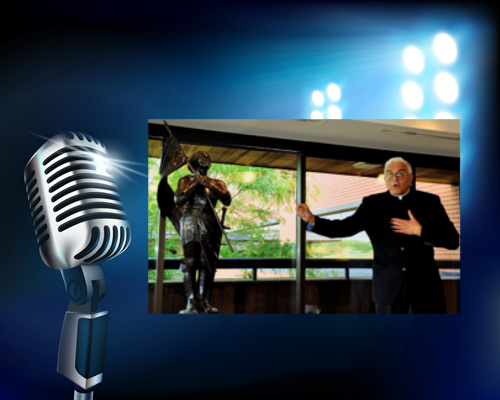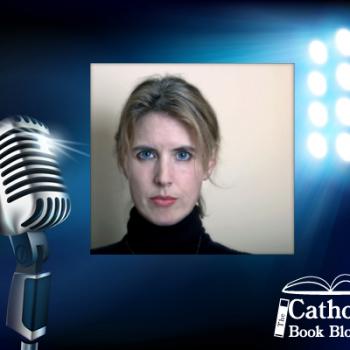 PETE: What drew you to Joan of Arc that resulted in your writing For God and Country?
PETE: What drew you to Joan of Arc that resulted in your writing For God and Country?
FATHER MICHAEL CERRONE: After twenty years as a priest and ten as an Army chaplain, I was asked by a fellow Catholic chaplain the date of my ordination. When I told him May 30, 1981, he immediately exclaimed, “Oh, that’s Saint Joan of Arc’s feast day!” That moment began my fascination with the French teenage girl soldier who was burned at the stake exactly 550 years before I became a priest. At my first opportunity from chaplain duties, I visited Domremy, the place of Joan’s birth and baptism in the Lorraine province of France. I spent time in the house of her birth, in the medieval church of her baptism, in the gothic shrine built to honor her memory and invoke her intercession, and even in the gift shop, where I obtained books and souvenirs.
I have returned to her village hometown six or seven more times, either alone or with other American friends. During my last assignment as an army chaplain at Fort Benning, Georgia, I decided to write about that remarkable young virgin who answered a unique call from Almighty God to lead soldiers in a just war against the invading English, in order to liberate her homeland and unite her countrymen under the rule of their king, a vassal of Christ the King of kings.
The more I read about her, the more my fascination grew. I outlined my project according to the chapters of her life and death and her enduring influence on France, the Church, and the world. The main title of my book For God and Country refers both to the U.S. army chaplain corps motto, “Pro Deo et Patria,” and to Saint Joan of Arc’s motivation for undertaking her mission. I share Sam Clemens’ (Mark Twain) sentiments about his own historical novel on Joan of Arc, “I did it for love not for lucre!”
PETE: I was really blown away with the comparison of the Passion of Christ to Joan of Arcs own Passion through a year imprisonment leading up to her death. What do you think this teaches people?
FATHER MICHAEL CERRONE: Our Lord Jesus Christ said that He was to be a suffering servant Messiah, a Christ crucified, and that His followers would share in His chalice of suffering. “Unless you take up your cross each day and follow me, you cannot be my disciples.” God the Holy Spirit brings this divine truth of redemptive suffering to fruition in the lives of God’s saints. Saint Peter was inspired to say, “You may for a time have to suffer the distress of many trials; but this is so that you faith, which is more precious than fire-tried gold, may by its genuineness lead to praise, honor, and glory when Jesus Christ appears.” And Saint Paul encouraged the faithful, “We make up in our own flesh what is yet lacking in the suffering of Christ for the sake of His Body, the Church.”
Both Peter and Paul became martyrs in Rome, inspiring many thousands of Christian faithful to follow them as martyrs as they had followed Jesus, the King of martyrs. Eventually the Christianization of the formerly pagan Roman Empire and the evangelization of peoples elsewhere resulted. In the late medieval period, Saint Joan of Arc’s passion during a year of imprisonment, corrupt trial, and cruel execution was even more Christ-like because she endured abandonment and the grossest injustices by both religious and secular authorities. At the end of my book, I added my poem “The Epiphany of Jesus and Joan,” which I had composed in 2010 just after attending the world famousPassion-Play in Oberammergau, Germany. A few verses from it:
The Passion-Play has now unfolded, for Jesus and for Joan –
His arrest and suffering was the pattern for her own.
Unjust trials and wicked high priests, Caiaphus then Cauchon,
In envy and with avarice used politics over religion –
One to appease a Roman governor, the bishop an English regent.
The Sacrifice on the Cross by Christ is the Father’s mercy revealed.
The Sacred Heart of Jesus’ wounds, in Body and in Soul,
Become the source of man’s salvation that sinners can be healed.
The sacrifice on the stake by Joan, her body in the fire,
Shows that nothing evil can ever destroy a pure-hearted love’s desire:
“Jesus! Jesus! Jesus!” Joan cried aloud and expired.
“Truly this was the Son of God!” proclaimed the Roman soldier with the lance.
“God have mercy, I burned a saint!” exclaimed the English soldier with the torch.
Jesus alone kindles the fire of the Holy Spirit’s love:
Joan’s soul is now aflame in Him among the saints above.
PETE: How can Joan of Arc be an applicable example and influence for people today?
FATHER MICHAEL CERRONE: Saint Joan of Arc was then and remains forever a great lover of God, the most Holy Trinity, and of all afflicted, abandoned, suffering humanity. From her childhood, she had a deep prayer life and a compassionate concern for poor, elderly, and oppressed people seeking refuge from the Hundred Years War between England and France and protection from rogue soldiers, bandits, and warring factions within the provinces of France. She showed her great devotion to Christ Jesus in frequent Confession and Communion and to the Immaculate Virgin Mother Mary in daily prayer and weekly pilgrimage to shrines. Later among the troops of all ranks and in encounters with aristocrats and commoners alike, she exhorted conversion from their sins of cursing, carousing, and drunkenness and their turning to prayer, the sacraments, and virtuous conduct even toward their enemies.
She led by example in the natural virtues of prudence, justice, fortitude, and temperance and the supernatural virtues of faith, hope, and charity. Twenty years after Joan’s death during an official tribunal from the victorious French king, testimonies taken from her friends and even some former opponents vindicated her heroic character, especially during her trial and execution. Her former page spoke of her extraordinary compassion in consoling even an English soldier mortally wounded by a Frenchman, ensuring that the dying man was confessed and forgiven. The Pope in Rome at the time nullified the condemnation trial proceedings and declared it and those who convened it and executed judgment of her as reprehensible!
PETE: You footnote a lot of resources in your book. Are there any in particular you can recommend for those who wish to take an even deeper look at the life of Joan of Arc?
FATHER MICHAEL CERRONE: I started researching Joan’s glorious life and martyrdom after my retirement from the army chaplain corps by reading books from 20th century scholars, especially by the French medieval expert Regine Pernoud, who wrote many books and articles on Saint Joan., and by many essayists giving their various perspectives on this amazing young woman and her impact on them. A book by Cristoir O’Floin entitled Three French Saints, subtitled “The One who led an Army,” was especially edifying to me.
I kept finding more and more books by authors from many countries outside France, and came to the conclusion that I had to stop reading other books and finish writing my own. Earlier this year, even as Sophia Institute Press was putting the digitized version on line and distributing the paperback books, I saw brand new books on Saint Joan. She continues to amaze and inspire thousands and even millions of souls around the world!
PETE: Time for my signature ending question. This is a blog about books. What books are currently on your bookshelf to read?
FATHER MICHAEL CERRONE: Since I have been quite mobile these last months, I have read only Fr. Andrew Apostoli’s excellent book on our Lady of Fatima. I have a gift copy of an American woman’s recently published book on Saint Joan of Arc, which I have perused. I will be reading a Marian scholar, Monsignor Arthur B. Calkins’ translated writings of a mystic, as well as the encyclical letter of Pope Francis and other works, once I get situated at Mary Queen of the Universe shrine basilica in Orlando, Florida, where I will assist in priestly ministry to tourists and pilgrims during the Year of Mercy. All your fellow bloggers are welcome to come visit that beautiful Marian shrine, especially in the winter months while I am there!
But in the summertime, you can also visit two places with magnificent statues of St. Joan which I personally commissioned: Fort Drum, NY (near Watertown) main chapel complex, with the “Pieta of Joan of Arc,” sculpture in bronze by Daniel A. E. Balan (himself a former combat soldier) expressing the compassion of Saint Joan for a dying English soldier; and Ann Arbor, MI at the Thomas More Law Center (within the Domino Farms building), with the “Saintly Soldier of Christ – Girl in the War,” sculpture in bronze by Julia Levitina, expressing the erect Joan holding her banner near her heart, ready to do battle against injustice for the cause of Christ. In life Saint Joan had a standard with the Holy Names of Jesus and Mary on it, which she preferred “forty times more than my sword.” By the way, my portion of all royalties from on-line and print book sales go to support ministry to combat troops in the Archdiocese for Military Services.
____________________________________________________________________________________________________











